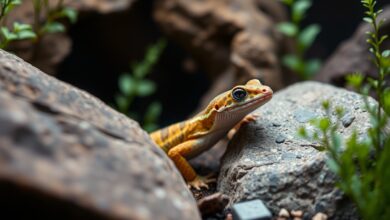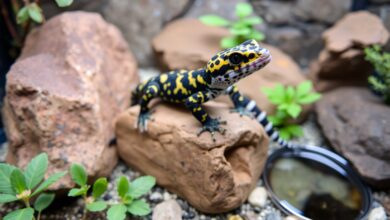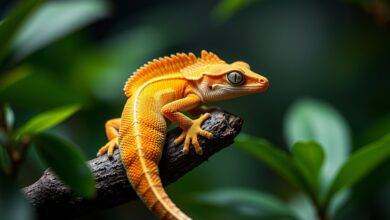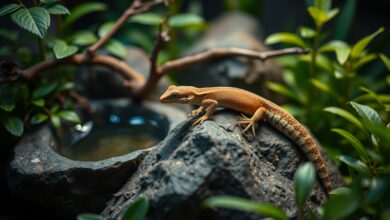Harlequin Crested Gecko – 6 Key Care Tips and Morph Details
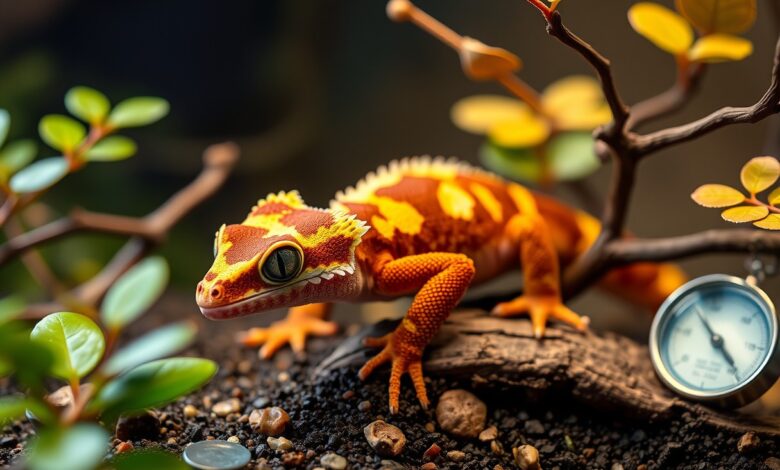
Care for your Harlequin Crested Gecko requires attention to specific habitat needs and dietary preferences to ensure a healthy and thriving pet. By understanding their unique morph characteristics and adhering to key care tips, you can enhance their well-being and longevity. This informative post will guide you through necessary practices, including temperature control, feeding habits, and handling tips, to help you create a loving environment for your gecko. With the right approach, you can enjoy a rewarding companionship with this stunning reptile.
Key Takeaways:
- Environment Setup: Provide a properly sized terrarium with vertical space, including hiding spots and climbing surfaces to facilitate natural behavior.
- Diet Variety: Offer a balanced diet that includes commercial crested gecko food, supplemented with insects and fruits to ensure proper nutrition.
- Handling Guidelines: Handle crested geckos gently and infrequently to minimize stress and establish trust, ensuring a positive interaction between pet and owner.
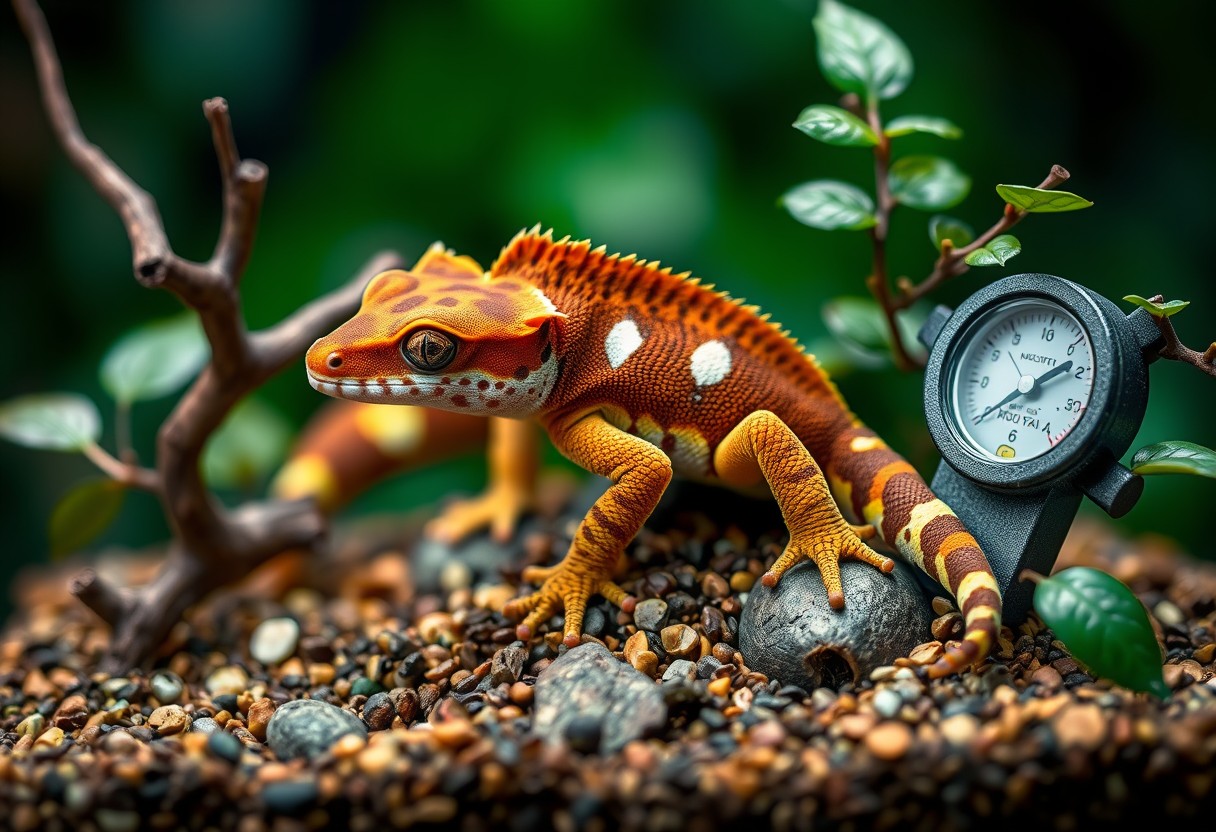
Understanding the Harlequin Crested Gecko
A Harlequin Crested Gecko is a stunning and popular reptile in the pet trade, well known for its unique coloration and affectionate nature. With a vibrant blend of patterns and markings, this gecko will quickly become a favorite in your collection. Understanding its needs and characteristics is imperative for providing the best care and ensuring a thriving environment.
Origin and Habitat
Between the lush rainforests of New Caledonia, the Harlequin Crested Gecko originally hails, thriving in habitats rich with humidity and diverse plant life. In this native environment, they have adapted to a variety of microhabitats, skillfully navigating trees and foliage as nocturnal hunters and shelter-seekers.
Physical Characteristics
Among the standout features of the Harlequin Crested Gecko are its impressive size, usually measuring around 8 to 10 inches, and its striking color patterns. These geckos often exhibit a mix of orange, yellow, and black patches, creating a visually appealing display. Notably, they have a unique *crested* ridge running along their heads and down their backs, enhancing their distinct appearance.
A well-proportioned and healthy Harlequin Crested Gecko has a robust body and a lively demeanor. Its skin is smooth and can vary in coloration from vibrant yellows to deep oranges, forming a natural camouflage among their leafy surroundings. The crests on their heads and along their backs are not only visually striking but also serve a purpose in social interactions, indicating health and status to potential mates or rivals. Maintaining optimal humidity and temperature in their habitat will ensure these geckos thrive and showcase their beautiful physical traits.
Key Care Tips
If you want to provide the best care for your Harlequin Crested Gecko, focus on the following key areas:
- Housing: Choose an appropriate enclosure.
- Temperature: Maintain proper heat levels.
- Humidity: Ensure the right moisture levels.
- Diet: Offer a balanced and nutritious diet.
- Handling: Be gentle and methodical.
- Health Care: Schedule regular vet check-ups.
Perceiving the needs of your gecko fosters a happy and healthy pet.
Ideal Housing Conditions
Housing your Harlequin Crested Gecko in a spacious, well-ventilated enclosure is important. A glass terrarium of at least 20 gallons is ideal, with ample vertical space for climbing. Use a substrate that retains humidity and offers a natural feel, like coconut fiber or plantation soil. Ensure the habitat includes hiding spots and branches for enrichment.
Temperature and Humidity Requirements
Conditions for your gecko’s well-being involve careful monitoring of temperature and humidity. Here is a quick reference:
| Temperature Range | Humidity Levels |
|---|---|
| 75°F to 80°F (24°C to 27°C) | 50% to 70% |
Temperature controls are vital as extremes can lead to health issues. Aim for a gradient within the enclosure, allowing your gecko to regulate its body temperature by moving between warmer and cooler areas. Use a reliable thermometer to maintain the proper levels.
Diet and Nutrition
Housing your gecko in a healthy environment is equally important as its diet. A well-balanced diet includes commercial crested gecko food alongside live insects. This combination provides all necessary vitamins and minerals for your pet’s growth and vitality.
For instance, specially formulated powdered diets provide easy, wholesome nutrition. You may also provide occasional live mealworms or crickets as treats, ensuring they are appropriately sized. Remember to provide fresh water daily for hydration.
Handling and Social Interaction
Across your gecko’s life, handling should be done gently and only for brief periods. Gradually increase handling time as your gecko becomes more comfortable with you. Approach them slowly to avoid stress.
Interaction can significantly improve the bond between you and your gecko. Regular, gentle handling allows your pet to acclimatize to your presence, establishing trust. Always support your gecko adequately to prevent falls and minimize stress.
Health and Veterinary Care
Social interactions play a role in maintaining your gecko’s health. It’s important to monitor for any stress signs or illness, such as lethargy or appetite loss, and seek veterinary care when needed.
Also, routine check-ups with an exotic pet veterinarian help you keep your gecko in optimal health. Be proactive about recognizing behavioral changes and create a comfortable environment, as this positively influences your gecko’s overall well-being.
Morphological Variations
Now, the Harlequin Crested Gecko showcases a wide range of morphological variations that make it an intriguing species for reptile enthusiasts. These variations arise from genetic factors that influence traits such as color, pattern, and size. Understanding these unique features can help you choose the perfect gecko that meets your preference and care requirements.
Color Patterns and Genetic Traits
Beside the striking visual appeal of Harlequin Crested Geckos, their color patterns and genetic traits play a significant role in their overall appearance. You will often observe vibrantly colored scales, ranging from deep oranges and reds to subdued browns and yellows. These traits result from specific genetic combinations, which can also affect the intensity of their patterns.
Common Morphs and Their Features
Around this captivating species, you will find several common morphs, each with distinct characteristics that set them apart. These include the definitive *Harlequin* morph, which displays a vibrant color palette and unique patching, as well as *Mosaic* and *Phantom* morphs, each offering variations in patterns and hues.
For instance, the *Harlequin* morph is well-known for its unique combination of colors and patterns, often showcasing a stunning array of patches. On the other hand, the *Mosaic* morph features randomly distributed color spots that create an eye-catching effect. Additionally, the *Phantom* morph possesses a distinctively soft, muted tone that can add elegance to your collection. These variations can significantly influence your decision-making process, as certain morphs might be more suitable for beginners while others may demand more advanced care practices due to their specific needs.
Breeding and Reproduction
Keep your Harlequin Crested Geckos in optimal health to encourage successful breeding. Understanding their genetics is vital; refer to the Crested Gecko Morph / Trait Guide to help you select breeding pairs that can produce desirable traits.
Breeding Tips for Success
One of the best ways to ensure a successful breeding outcome is by focusing on health and environment. Consider the following tips:
- Monitor temperature and humidity levels
- Provide a balanced diet
- Observe behavior during breeding season
- Isolate females post-ovulation to prevent stress
Thou should also keep records for future breedings.
Understanding the Lifecycle
Any breeding journey starts with comprehending your Crested Gecko’s lifecycle. From the moment of fertilization, females carry eggs for approximately two to four weeks before laying them. Eggs typically hatch within 60-90 days, depending on environmental conditions.
Lifecycle stages are marked by vulnerability and growth. After hatching, juvenile geckos require a safe, enriched environment to thrive. During this stage, they face high risks from their surroundings. You must provide optimal conditions to ensure they reach maturity, showcasing their vibrant colors and unique patterns. Regular monitoring and proper care are key components in promoting their successful development into stunning adults.
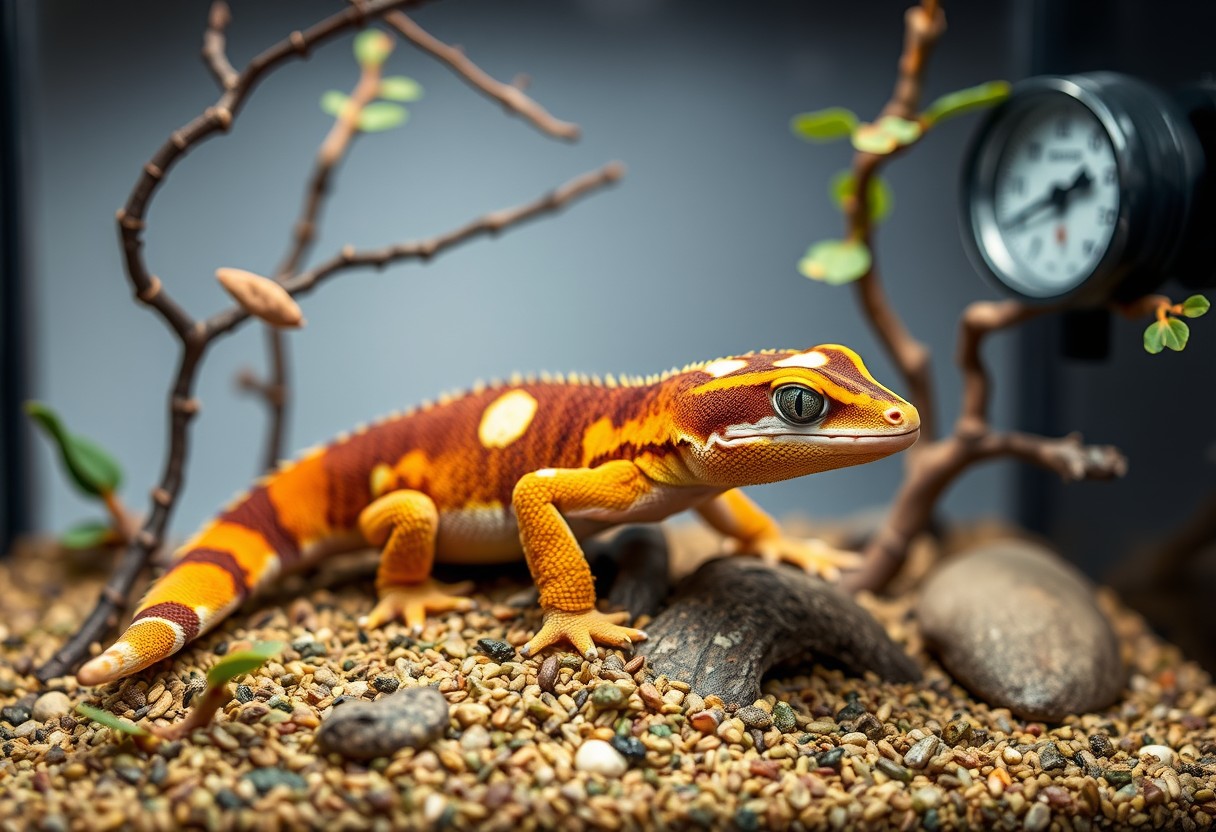
Common Challenges and Solutions
To effectively care for your Harlequin Crested Gecko, you may encounter specific challenges. For comprehensive information on the species, check out the Crested Gecko: Species Profile. Addressing diet, habitat, and health issues early on will ensure your pet remains happy and thriving.
Behavioral Issues
An understanding of your Crested Gecko’s behavior is necessary for addressing potential issues. If your gecko exhibits signs of stress, such as excessive hiding or lethargy, it might be due to environmental factors or inadequate handling. Pay attention to their body language and adjust your care routine accordingly.
Environmental Concerns
Beside behavioral issues, environmental factors significantly impact your gecko’s well-being. Ensuring proper humidity, temperature, and habitat conditions will create a healthy environment for your pet.
Understanding the importance of humidity levels between 50-70% and maintaining a daytime temperature range of 75-85°F is necessary for your Crested Gecko’s health. Improper temperature or humidity can lead to severe health problems such as respiratory infections and shedding difficulties. Additionally, providing adequate space and enriching their environment with climbing opportunities will help reduce stress and promote a more active lifestyle.

Resources for Harlequin Crested Gecko Owners
After bringing home a Harlequin Crested Gecko, it’s imperative to equip yourself with reliable resources that can help you provide the best care for your pet. This includes understanding their specific needs, habitat setup, and nutritional requirements. Investing time in gathering these resources will enhance your knowledge and ensure your gecko thrives in its environment.
Recommended Products
One of the best ways to ensure the well-being of your Harlequin Crested Gecko is by investing in high-quality products. Look for nutritional supplements, appropriate habitat decorations, and a suitable substrate that allows your gecko to feel secure and comfortable. Products specifically designed for crested geckos can greatly enhance their health and happiness.
Online Communities and Forums
After establishing your gecko’s habitat, connecting with other owners through online communities and forums can provide you with invaluable insights. Engaging in discussions will allow you to share experiences, ask questions, and learn best practices from seasoned owners.
Further, these online platforms serve as a wealth of shared knowledge where you can find tips about feeding schedules, health care, breeding advice, and popular products among enthusiasts. By participating in these communities, you also create opportunities to connect with other dedicated Harlequin Crested Gecko owners, building a network that supports your pet’s health and well-being.
To wrap up
To wrap up, caring for a Harlequin Crested Gecko requires your attention to specific aspects such as temperature, humidity, diet, habitat, health monitoring, and breeding considerations. Familiarize yourself with their morph details to appreciate their unique traits, which can enhance your experience as a pet owner. By following these six key care tips, you can ensure your gecko thrives in a healthy and stimulating environment, allowing for a rewarding companionship between you and your pet.
Q: What are the vital habitat requirements for a Harlequin Crested Gecko?
A: Harlequin Crested Geckos thrive in a well-structured habitat that mimics their natural environment. An ideal enclosure should be at least 20 gallons, with vertical space for climbing. The temperature should be maintained between 72°F to 80°F, and humidity levels should range from 50% to 70%. Provide plenty of hiding spots using plants, branches, and logs to help them feel secure. A substrate like coconut fiber or reptile carpet can help maintain humidity while offering a comfortable surface for the gecko.
Q: What dietary needs should I consider for my Harlequin Crested Gecko?
A: The diet of a Harlequin Crested Gecko mainly consists of a balanced meal replacement powder (MRP) that includes insects and fruit purees. These geckos do best with a varied diet, so occasional feeding of small insects, such as crickets or mealworms, can provide necessary protein. Offer these insects every few feedings, and ensure they are properly gut-loaded and dusted with calcium and vitamin supplements to promote health. Fresh fruit puree can be an alternative occasional treat, but avoid citrus fruits.
Q: How can I maintain the health and well-being of my Harlequin Crested Gecko?
A: Maintaining the health of your Harlequin Crested Gecko involves regular monitoring of temperature and humidity levels in the habitat, providing fresh food and clean water daily, and performing routine cleaning of the enclosure to prevent bacterial growth. Regularly check for signs of stress or illness, such as lethargy, loss of appetite, or unusual shedding. A veterinary checkup with a reptile-specialized vet should be part of your routine care, especially if you notice any changes in behavior or health.


